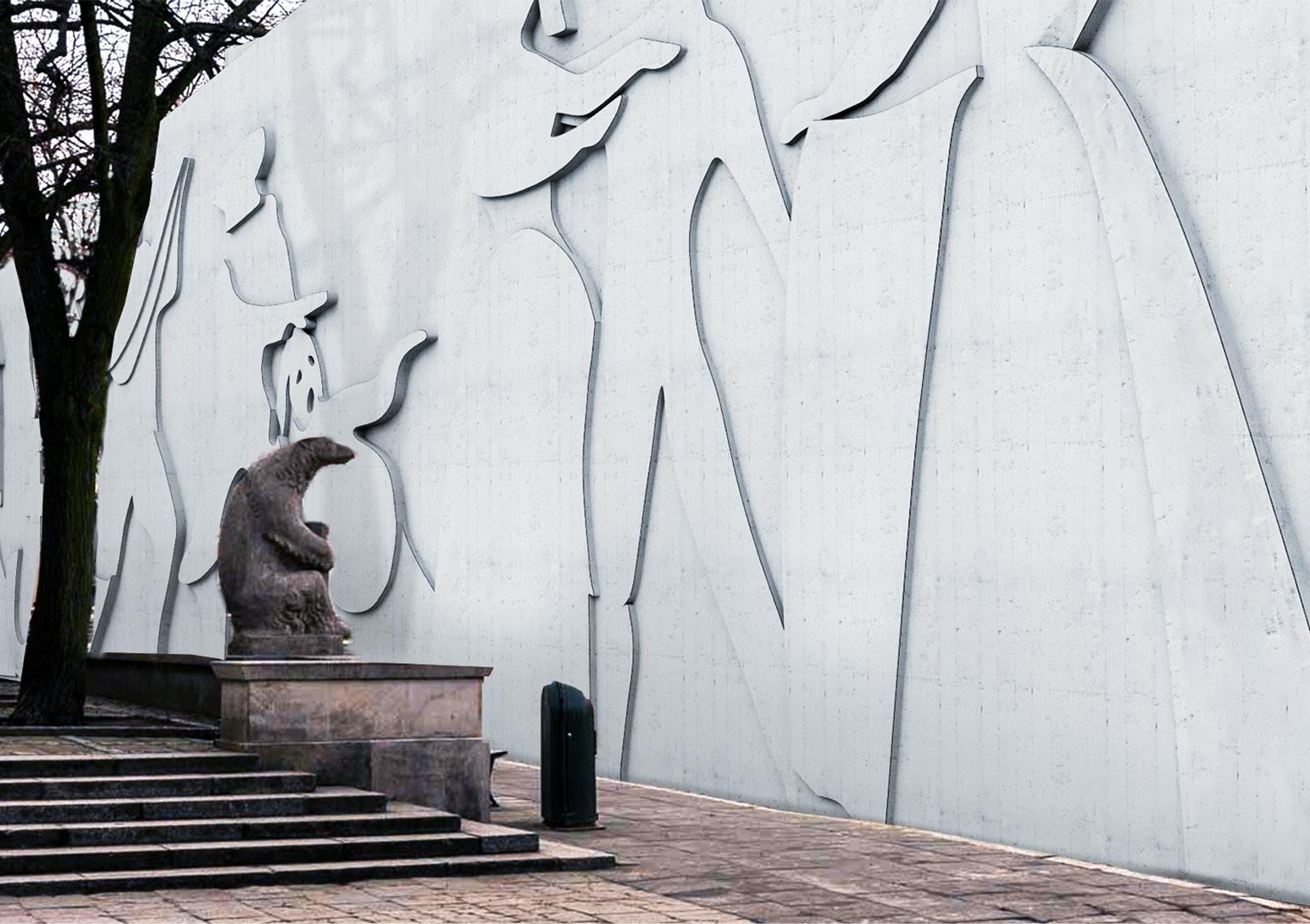
"Idlehandsarethedevil'sworkshop".

MARECHAL CARMONA
Residential, Cascais, Portugal
VILA MODER
Residential, Gomes Freire, 2017 - 2018

Pag. 6 - 21
WARSAWCALL
Cultural Warsaw, Poland
2019 - Present 2020
Pag. 38 - 49
Pag. 22 - 37
VERTICAL URBAN FACTORY
Cultural, Beato, Portugal
2019-2020

Pag. 64 - 77





VERTI CAL UR BAN FAC TORY
Master Thesis Beato, Portugal
November 2020
Honorable Mention - StandoutArchi Contest


First Place - A4TC Thesis Competition.


Third Place - Architecture Thesis of the Year








third floor plan fourth floor plan






20

21
A HYBRID HALL
3rd Place - ArchiContest - WarsawCall March, 2021 Warsaw, Poland


The city of Warsaw, due to its constant rebuilding throughout the XX century, was dubbed the Phoenix city, as it has risen from the ash various times. This continuous rise and fall, established a formidable historical city that valued its heritage by its replication throughout its rebuilding phases. This meant that part of that value lied in its public spaces, and that Warsaw’s squares and parks would be more than public spaces, they would be cultural heritage.

22

23

24

25

26

27



30

31

32
The brief required us to intervene in one of these spaces – In particular the New Town Market Place in the Warsaw center.
The New Town Market Place, being the main square of the Warsaw New Town, was rebuilt multiple times in various degrees and shapes – from a 140 by 120-meter square to a skewed 90-meter-long Market Place with a curved townhouse block occupying the original square area. Today, the square itself is punctuated by several sculptures and flowerbeds that bridge small gaps in height and a fountain atop of a small staircase on the lower corner of the area. The surrounding context of yellow and red grouted brick townhouses, and accentuated small ground floor amenities lighten, the otherwise grey square. On the far end of the curved townhouse block, is an orthodox church forming a misaligned axis towards the square entrance. This square is crucial not only as a main public space in the New Town, but to Warsaw in general.
We were tasked to create a 500-seat concert hall in this space, a typology that concurrently has a predominately private and sparring use.
Since the square was of utmost importance, it was imperative to intervene in such a way that would preserve the square’s hereditary value, and not create an obstacle to the square itself.
But how can one conceive of a predominately private building typology on a valued public heritage square?
We chose to invert the traditional concert hall typology and merge it with the square itself, essentially democratizing it by creating a public square concert hall hybrid.
We started by raising a traditional townhouse volume on the south side of the square and then sectioning it with two important axis: a mirrored curve from the townhouse block (framing the church as a main element in the square), and the area of staircase leading to the fountain. These sectioned surfaces are then framed with glass, conceiving the main facades of the building and creating the main entrance as a continuation of the fountain staircase. Then, the resulting west volume end is lowered to ground level, creating a public green roof as a prolongation of the square itself.
The building itself is organized in order to concentrate the more public functions on ground level, and distribute the more private ones beneath. All the public programs (musical shops, coffee shop and concert hall) were conceived as concrete cubes, each containing curtain-like curved openings as entrances which are accentuated via the curved glass façade which slightly distorts each one, creating a stagelike expression towards the exterior. Beneath, the workshops and music studios are punctuated by green patios which grow upward relating themselves with the square and providing natural l.
The building, as a whole, is clad in varying types of concrete (polished floors and bush hammered walls), assuming its austere expression. It’s curved glass, interrupts this austereness by creating curtain-like surfaces, giving it a theater-like character.
The south façade is then molded to form various traditional Warsaw symbols as concrete “frescos”, such as the Syrenka and Kotwica, interpreted as theater characters, as seen in various paintings in the surrounding context. Finally, the auditorium is then clad in wood and glass, respecting the circular pattern from the exterior and unfolding it throughout the space, creating a weaving, tubular structure, that blends and diffuses walls, roof and floor as one.
33
MARE CHAL CAR MONA
2019 - Present Cascais, Portugal
Residential

Down the river in search of the sea, it is a 30-minute train ride that separates Lisbon and Cascais. Through windows, the various frames of the great river and its Atlantic mouth, the passing of time and collective memory, stories about stories marks the approach to the Marechal Carmona neighborhood, opened in 1946 as a response to the housing shortages of the time.
The project challenged us to rehabilitate this dying, albeit characteristic neighborhood in the heart of Cascais by adding to it 500 more dwellings while simultaneously attempting to preserve its character.
The project was comprised of an urban plan as well as several, more detailed interventions including various housing projects, a kindergarten, a school and a multifunctional building. Here I will be focusing on the residential project.



PRE-EXISTING DWELLINGS

All of the pre-existing dwellings provided a private front yard that created a particular sense of community
INCREASED DENSITY
How could one triple the existing density while maintaining this sense of community?

VERTICAL STACKING DIVERSIFY
By stacking both vertically and diagonally one can simultaneously preserve the pre-existing way of living and accommodate new dwellers altogether.
Each block was then pushed in different directions, creating varying typologies throughout the whole area




ground
plan first
plan 28
floor
floor
As part of a shift in paradigms and counterpoints and for the prototype of a good city, the urban requalification of the neighborhood is proposed, with a view to promoting a dynamic, multifunctional and multigenerational city, preserving the sense of community and the values inherent to this heritage, alive.
The neighborhood, characterized by outdated and narrow housing typologies, where the aging of the population and a high level of inactivity is felt, seeks, based on its privileged location in relation to the center of Cascais town and surrounding accesses, to regenerate its image , consolidating it with its current inhabitants, and attracting new activity.

29


section
longitudinal



cross section
third floor plan
fourth floor plan




ALÇADO POENTE ALÇADO east elevation
General Axonometric View



Cultural Axis
Public Spaces
34

35

Plan
Urban








Projects Developed in the Urban Plan
VILA MODER
Studio project 3rd year 2nd semester
Gomes freire, Lisbon Housing

The increasing population density in Lisbon due to it’s rise in popularity in touristy routes has, undoubtedly been one of the most impactful phenomena in the city’s context. Once, as an high density and generally low-rise city, Lisbon was defined by its narrow streets, varied façades and confusing walkways. While at the current moment, thanks to the widening of the streets and the increasing height of buildings, is slowly becoming a generic 21st century city filled with boring blocks of vertically stacked office buildings with a touristy centred architecture, meaning it looks like it but it isn’t actually it. Once as a community centred low rise high density, now, soon-to-be profit-driven high rise, high density.
This led to one of the key features of the city, its enormous sense of community, to slowly fade away, thanks to the decrease in restrictiveness which, ironically is what gave it identity in the first place.
So the question arises if this sense can actually be brought back without the increasing publicity of the city affect it?



SMALL SCALE COMMUNITIES

LIFTED FOR PUBLIC SPACE
By taking small scale communities, creating common patios for each one and lifting the whole structure from the ground for public space, you end up establishing restrictive common space for the housing in the upper area and mitigating, in a way, the public beneath.

42

43

44

45

46


47


49





52

53
INTERIOR DESIGN
Work at Nainoa: Achitecture and Interiors New York, US

As a member of the interior design team at Nainoa, I was dedicated to creating functional and visually appealing interior spaces that met the unique needs of each client. I collaborated with architects, contractors, and other design professionals to bring design concepts to life.
My work at Nainoa allowed me to further develop my technical skills in drafting and detailing, while also honing my ability to effectively communicate design concepts to both clients and project teams.





















































































































